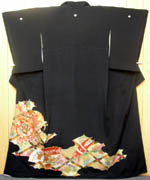Gagaku kurotomesode
Last week I won a kurotomesode that absolutely takes my breath away:

(photo taken by ebay seller ryujapan-99, who has a great selection.)
Closeup of the pattern
It’s my size (164cm – ideally I would take a kimono my height, or 178cm, but I can wear one as short as 160 and still have a passable ohashori; yet 160cm is still longer than the vast majority of used women’s kimono), in excellent condition, has motifs close to my heart, having studied music most of my life, and is double lined – not so rare, but not common, either. There was also a surprise awaiting: a knowledgeable kimono-loving friend noticed that the fans on it are akomeougi, used in the Heian period by women. A couple links on fans:
o Akomeougi (photos)
o Japanese lesson on sensu and ougi
Inspired by my new kurotomesode and wanting to figure out the symbolism in as much detail as possible, I looked for specific information on the instruments portrayed. There are flutes (shakuhachi, but they could also be hichiriki), kakko (a Heian side drum, looks like the modern kotsuzumi) and sho, a multi-reed, multi-pipe instrument that sounds a bit like a cross between a bagpipe and an organ, with an alto-soprano range. For further information on the instruments:
o Nipponia: The Color of Japanese music (be sure use the small “next” button at bottom)
o Japanese Flutes
o History of the sho
o Early Japanese music
o Gagaku (just the front page is in English, rest is in Japanese)
As you can see from the links, “gagaku” is mentioned often: this is court music which originated in the Heian period, and is still performed today. A gagaku ensemble is lead by the concert master, playing the kakko, and includes several different instrument types.
Taking into consideration the akomeougi, which hint at demure Heian ladies who would be behind them, it seems likely that my kurotomesode is meant to suggest a small Heian court concert. In addition, the significance of autumn and winter motifs in the dyed background circles becomes clear from the section on symbols in the book The Techniques of Japanese Embroidery: “The arrival of lengthening nights of autumn signaled the time for reading and music.” “Musical instruments […] suggest autumn. The most sophisticated music of court life was that derived from ancient Chinese court music and dance, called gagaku.” Thus the motif is, unsurprisingly, very appropriate for a kurotomesode, the most formal of kimono for married women.
I love formal kimono for the treasure hunts in symbolism they offer, and will be sure to add anything new I discover once I receive this one in the mail and get to see it in real life.